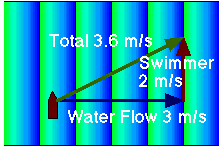


The most common form of vector addition problem is the adding of velocities. For example, we will now deal with a swimmer crossing a flowing stream. In this case the vector equation looks deceptively simple, like this:
where ![]() is the velocity of the swimmer and
is the velocity of the swimmer and ![]() is the velocity of the water, as shown in this animation.
is the velocity of the water, as shown in this animation.
Question:
A stream flows at 3 m/s and is 100 m wide. You want to swim across at 2 m/s. Do you ever make it? How long does it take, and where do you end up? (Take the x-axis to be in the stream direction and the y-axis to be across.) What is? (work in x- and y-components)
Answer:
The components of the vectorsand
are:
sy = 2 m/s; sx= 0; wy = 0; wx= 3 m/s For their sums we then get:
vy= sy + wy = 2 m/s + 0 m/s = 2 m/s and
vx = sx + wx = 0 m/s + 3 m/s = 3 m/s the magnitude and direction of v are given by
v = (vx + vy )1/2= (22+32)1/2 = 3.6 m/s
tan -1(2/3) = 33.6°
Question:
How much time does it take the swimmer to cross a 100 m wide stream?
Answer:
We can use one of our kinematic equations from the previous chapter:y = y0 + vy0 $\cdot$ t(no acceleration) with y0= 0, vy0 = 2 m/s, y = 100 m
\[ \rm t = \frac{y-y_{0}}{v_{y0}} $\Rightarrow$ t = 50s \] This is the same time it would have taken without current! But this is a special case, because the swimmer swims exactly perpendicular to the current.
Question:
How far downstream does the swimmer end up on the other shore?
Answer:
Again we resort to our kinematic equation, this time calling the variable x instead of y:x = x0 + vx0t with x0 = 0, vx0 = 3 m/s, t = 50 s
=> x = (3 m/s) $\cdot$ (50 s) = 150 m
Question:
What is the total distance swum?
Answer:
The total distance we obtain from Pythagoras' Theorem as:d = (x2 + y2)1/2 = (1002 + 1502)1/2 m = 180.3 m
Question:
What was the swimmer's speed as observed by somebody standing on the shore of the river?
Answer:
We can get the speed in two different ways:
- Since we know the individual velocity components of
, we can calculate the length of that vector to get the speed:
v = (22 + 32)1/2 m/s = 3.61 m/s - We also already calculated the total distance swum and the time it took. Take the ration of these two, and hopefully you will get the same result:
\[ \rm v = \frac{d}{t} = \frac{180.3 m}{50 s} = 3.61 m/s \]
Question:
Now the hard problem. How do I swim to get directly across? In mathematical terms, how can I have Vx = 0?
Answer:
It is impossible because || > |
|. Even if I swim directly upstream, I still have an x-component.
 Make
a new problem with a boat that can go 5 m/s.
Make
a new problem with a boat that can go 5 m/s.
Question:
Which angle does this boat have to select to get directly across the stream?
Answer:
![]() must be
at an angle such that vx = 0. But vx = w - s
sin
must be
at an angle such that vx = 0. But vx = w - s
sin
Question:
How long does it take?
Answer:
The stream is 100 m wide. So all we need to do is to calculate the y-component of our velocity vector, and divide 100 m by it:vy = s cos $\theta$ = 5 m/s cos 37º = 4 m/s
\[ \rm t = \frac{y}{v_{y}} = \frac{100 m}{4 m/s} = 25 s \]
Note that if I had headed straight across, it would have taken 100/5 = 20 s, but I would have ended up 60 m downstream.
© MultiMedia Physics, 1999